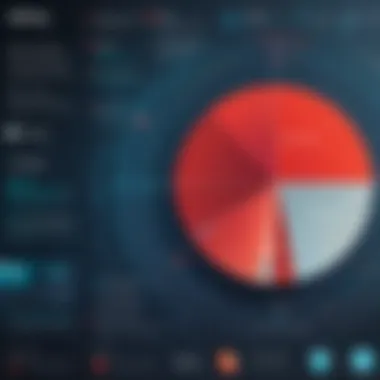Analyzing the Red Canary Report for Cybersecurity Insights


Intro
In the ever-evolving landscape of cybersecurity, the Red Canary Report stands out as a beacon for professionals seeking to enhance their threat detection capabilities. This document lays bare critical findings, offering a roadmap for organizations eager to fortify their defenses against an increasingly sophisticated array of cyber threats. It goes beyond mere statistics or theoretical analysis; it presents actionable insights derived from meticulous research and real-world case studies.
The relevance of the Red Canary Report cannot be overstated. As new technologies emerge and the digital footprint of businesses expands, so too does the landscape of potential vulnerabilities. Threats evolve rapidly, and traditional security measures often fall short. Here’s where a comprehensive understanding of the Red Canary Report comes into play, providing a framework for organizations to respond swiftly and effectively.
Prelims to the Red Canary Report
In the fast-evolving landscape of cybersecurity, the Red Canary Report stands out as a critical resource for professionals and enthusiasts alike. This document isn’t just another paper filled with jargon; it offers a fine-tuned look at how organizations can heighten their awareness and bolster their defenses against evolving threats. Diving into the nuances of this report is essential for anyone serious about understanding threat detection methodologies and incident response strategies. It’s akin to having a treasure map in a world riddled with pitfalls. By grasping the insights shared in this report, security practitioners can navigate the complexities of modern cybersecurity with confidence.
Purpose and Scope
The Red Canary Report aims to illuminate the dark corners of threat detection and incident response. Its purpose extends beyond mere documentation of threats; it seeks to provide actionable insights that organizations can implement in their security frameworks. The scope of the report encapsulates a range of cyber threats from basic phishing attacks to advanced persistent threats that challenge even the most fortified systems. Here’s what the report touches upon:
- Comprehensive Analysis: It breaks down common vulnerabilities and how they can be exploited by attackers, ensuring that professionals stay alert.
- Incident Response Practices: Clear guidelines are laid out to improve reaction times when an incident occurs. These best practices serve as a blueprint for efficiency.
- Real-World Examples: The inclusion of case studies makes the theoretical aspects more tangible, showcasing how companies successfully navigated crises, thereby providing lessons that are applicable in various settings.
Historical Context
To truly appreciate the Red Canary Report, one must understand its historical foundation. Over the past decades, cybersecurity has transformed dramatically, shaped by technological innovation and increasingly sophisticated attack methods. Initially, organizations relied on basic firewalls and antivirus software, often blind to the subtle nuances of advanced threats. However, as cyber attacks grew more sophisticated, there was a tangible shift in perspective.
This document arose from the need for organizations to adapt quickly. The historical context behind it is pivotal; it reflects the evolutionary trajectory of threats and responses in the cybersecurity field. The surge in data breaches and high-profile incidents opened a floodgate of information sharing among professionals. Red Canary took the initiative to harness this flood of experiences and compile those lessons into a structured format accessible to everyone.
Archives of previous years’ reports, coupled with practical insights, enable current and future cybersecurity initiatives to be both reactive and proactive. This historical journey not only provides context but also highlights how far organizations have come and what lies ahead in the realm of cybersecurity.
"Understanding the past is crucial for every organization; knowing historical attacks can prevent future mishaps."
In summary, the Red Canary Report serves as a beacon for organizations seeking to reinforce their defense mechanisms and foster a culture of continuous improvement with respect to cybersecurity awareness.
The Evolution of Threat Detection
The landscape of cybersecurity is in constant flux. As threats evolve, so too must the methodologies used to detect and respond to them. Understanding the evolution of threat detection is crucial not just for professionals all drenched in technology but also for decision-makers looking to safeguard their organizations. This evolution highlights a journey from rudimentary methods to sophisticated frameworks, underscoring demands of a digital age where threats can emerge from the unlikeliest corners of the web.
From Traditional to Modern Methods
In the earlier days of cybersecurity, practices primarily revolved around signature-based detection. This means systems looked for known malicious software based on specific signatures. While this was somewhat effective in dealing with known threats, it left organizations vulnerable to novel attacks. Imagine it like checking for a wolf in sheep's clothing; if the wolf changed its outfit, it could slip by unnoticed.
As cybercriminals became more adept, traditional methods grew inadequate. This prompted the shift toward behavior-based detection methods, which started looking at what activities are suspicious. For example:
- Unusual login times
- Out-of-pattern data transfers
This newer approach allows for capturing anomalies that aren't necessarily tied to a known signature. But even that started to experience its share of pitfalls, as bad actors adapted faster than systems could keep up. So, the need for modern methods surged to the forefront, leading us into the current realm of advanced threat detection.


Tools such as endpoint detection and response (EDR) are now commonplace, offering a comprehensive analysis of activities across devices. These modern systems are capable of learning from ongoing patterns, thereby evolving with every interaction. By integrating threat intelligence and analytics, they build a framework that isn't simply reactive but proactive.
The Role of AI and Machine Learning
Artificial Intelligence and Machine Learning have ushered in a new era for threat detection. They enable systems to sift through vast oceans of data, pinpointing threats that would otherwise blend into normal activity. It's like having an ultra-efficient librarian who not only knows where every book resides but can also deduce which ones might likely be checked out tomorrow based on current trends.
AI algorithms can analyze behaviors across networks, learning to identify what is normal and what isn't. This creates an intelligent environment that evolves and adapts over time. Here are a few elements to consider:
- Anomaly detection
- Predictive modeling
- Automated incident response
With these technologies, organizations can proactively combat evolving threats rather than simply respond to breaches as they arise. A significant advantage here is the enhancement of incident response metrics that can identify issues long before they escalate into full-blown crises.
"In a world where cyber threats grow unchecked, evolution is not just a choice, but a survival strategy."
As we move forward, it's essential for organizations to embrace these modernized processes. Tech-savvy decision-makers must remain vigilant, fostering an environment rich with continual learning and adaptation toward emerging dangers. The essence of threat detection has transformed — from basic identification to sophisticated forecasting, driven by an understanding of human behavior and machine learning capabilities.
Understanding these shifts isn't just an academic exercise; it's a necessity to navigate today’s volatile cyber threats effectively.
Key Findings in the Red Canary Report
The Red Canary Report stands as a critical piece in the cybersecurity landscape, shedding light on various aspects of threat detection and response mechanisms. Understanding the findings from this report is paramount for any organization aiming to bolster its security posture. In a world awash with rapidly evolving threats, identifying key insights can mean the difference between proactive security measures and catastrophic breaches.
Overview of Threats Identified
The report meticulously catalogs a range of threats faced by modern organizations. It highlights not just the existence of these threats, but also their characteristics and the methodologies employed by attackers. For instance:
- Phishing Attacks: These remain a bane for many—often the gateway for more severe breaches, phishing attacks exploit human error, nudging unsuspecting employees to reveal sensitive information.
- Ransomware: The rise of ransomware attacks in recent years is alarming. Organizations find their critical data hijacked until a ransom is paid, and the financial implications can be staggering.
- Advanced Persistent Threats (APTs): These sophisticated threats involve attackers gaining and maintaining unauthorized access to networks over extended periods. Detecting APTs is challenging, requiring a nuanced understanding of the network environment.
The identification of these threats within the Red Canary Report allows organizations to prioritize their defenses and tailor training and awareness initiatives effectively. The specific aggregation of threat intelligence provides a framework from which security teams can develop defensive tactics.
Incident Response Metrics
An integral component of the Red Canary Report lies in its exploration of incident response metrics. The data here isn’t just a collection of numbers; it's a translation of actions taken during an incident and a measure of how effectively an organization responded.
Some significant metrics highlighted include:
- Time to Detection: The ability to detect an incident swiftly is crucial. Delays can lead to greater damage, so understanding average detection times is key.
- Time to Containment: This metric gauges how quickly an organization can limit the damage of an incident once it’s detected. Quicker containment usually correlates with reduced impact.
- Impact Assessment: Understanding the quantitative and qualitative effects of an incident helps organizations recover and return to business-as-usual more seamlessly.
The importance of these metrics cannot be overstated. They serve not merely as retrospective assessments but as fundamental criteria that guide ongoing improvements in an organization’s incident response strategy.
In analyzing these findings, organizations are not left to flounder in a sea of uncertainty. Instead, they gain a reliable compass for navigating their cybersecurity landscape. As a result, emerging from the Red Canary Report is not just an understanding of today’s threats, but a clearer pathway to a more resilient future.
Advanced Threat Detection Frameworks


In the rapidly changing landscape of cybersecurity, frameworks for advanced threat detection serve as a crucial backbone for organizations aiming to fortify their defenses. These frameworks help in methodically identifying potential vulnerabilities and addressing emerging threats, thereby ensuring a robust security posture.
The complexity and sophistication of cyber threats today requires organizations to adopt structured approaches to threat detection. Understanding these frameworks is not just about recognizing their existence; it's about comprehending their mechanics, applicability, and potential impact on an organization’s overall security strategy.
Understanding the Frameworks
At the heart of advanced threat detection frameworks lies the notion of proactive versus reactive measures. While traditional approaches often focus on responding to threats after they occur, modern frameworks prioritize early detection and preventative strategies. A framework typically comprises a set of guidelines, methodologies, and best practices that institutions can tailor to their specific needs.
Some prominent frameworks include:
- MITRE ATT&CK: A knowledge base of adversary tactics and techniques based on real-world observations.
- NIST Cybersecurity Framework: A comprehensive outline that focuses on managing cybersecurity risk.
- CIS Controls: A prioritized set of actions to protect organizations and data from prevalent cyber attacks.
Each framework presents unique principles, yet they collectively emphasize continuous monitoring, intelligence sharing, and incident response readiness. This is crucial in a world where threats evolve at lightning speed.
Benefits of Implementing Frameworks
Implementing advanced threat detection frameworks offers a myriad of advantages:
- Improved Threat Visibility
By utilizing established frameworks, organizations gain enhanced visibility into their threat landscape. This allows for better-informed decision-making and resource allocation. - Standardized Processes
Frameworks provide a structured approach, enabling organizations to implement standardized processes across the board. This leads to more effective and scalable security measures. - Regulatory Compliance
Many frameworks align with industry standards and regulations. By adopting them, businesses can ensure compliance, thus avoiding potential fines and legal issues. - Enhanced Incident Response
Frameworks often incorporate guidance on incident response strategies, which can minimize the damage caused by breaches and enhance recovery processes. - Community Collaboration and Intelligence Sharing
Engaging with frameworks that promote collaboration fosters relationships within the cybersecurity community, allowing for the sharing of threat intelligence and practices that could be vital for defense.
Frameworks, when effectively integrated into existing security practices, can be a game-changer in how organizations tackle cyber threats, steering them towards a more resilient and proactive security posture.
Thus, recognizing and implementing advanced threat detection frameworks is not just a best practice; it’s a necessity in the ongoing battle against cyber threats. As new threats emerge, these frameworks help organizations stay ahead of the curve, adapting their strategies for better defense. The journey to a secure future begins with understanding these essential tools.
Real-World Applications
In considering the significance of the Red Canary Report, real-world applications offer a tangible lens through which the theoretical aspects of cybersecurity can be understood. This section illustrates how organizations can apply the insights derived from the Report to bolster their security measures effectively. The strength of this report lies not only in its findings but equally in how these findings translate into actionable strategies for those on the front lines of cybersecurity.
The immediate benefits of implementing these real-world applications are multi-faceted:
- Enhanced Incident Response: By aligning incident response protocols with the findings laid out in the report, organizations can improve their ability to react swiftly and effectively during security breaches.
- Proactive Threat Mitigation: Instead of merely reacting to threats after they occur, companies can equip themselves with methods to anticipate and neutralize potential risks ahead of time.
- Strategic Resource Allocation: Understanding where threats are likely to arise allows for more meticulous planning and allocation of cybersecurity resources, ensuring optimal defense mechanisms are in place where they matter the most.
Case Studies Highlighting Success
Exploring case studies that embody the principles presented in the Red Canary Report provides a crucial understanding of its practical application. One such example can be seen in a mid-sized financial institution that adopted the report's recommendations in a bid to strengthen its cybersecurity posture.
Case Study: Financial Institution
After discerning a spike in phishing attacks within their sector, the organization's IT security team decided to heed the insights from the Red Canary Report, particularly regarding the necessity for continuous training and monitoring. They implemented a dedicated awareness program, fostering a culture centered on vigilance. Participants experienced simulated phishing attacks, reinforcing their capability to identify suspicious activities.
The outcome?
- The number of successful phishing attempts dropped by over 60% within six months.
- Additionally, incident response times improved by 40%, allowing the institution to better counteract genuine threats quickly.
This case study exemplifies how applying learning from the Red Canary Report leads to significant success in mitigating threats and streamlining the organization's incident response processes.


Lessons Learned for Organizations
Drawing lessons from the applications of the Red Canary Report is paramount for all organizations navigating these complex cybersecurity waters. They must emerge not just as recipients of information but as active participants in evolution.
- Stay Updated on Threat Landscapes: The vectors of threats change as rapidly as technology evolves. Regular reviews of the Red Canary Report ensure that organizations remain ahead of the curve, adapting their strategies in real time.
- Build a Culture of Security: Organizations must prioritize embedding cybersecurity awareness into their corporate culture. Involving all employees—much beyond IT personnel—creates a united front against potential threats. Everyone should feel responsible for security.
- Leverage Collaborative Threat Intelligence: Engaging with external networks and resources can enhance an organization's perspective on threats. For instance, sharing insights with peers in one's industry can yield invaluable intelligence that informs response planning and threat detection strategies.
"Organizations that take the initiative to incorporate the findings of the Red Canary Report into their fabric can not only safeguard their own assets but also contribute to a more robust security community overall."
Future Directions in Cybersecurity
The landscape of cybersecurity is ever-changing, akin to a chameleon blending into its environment. Understanding future directions in this field is not just important; it's vital for organizations aiming to stay one step ahead of potential threats. As technology evolves, so do the strategies behind cyberattacks. Consequently, professionals must adapt continuously and incorporate these emerging trends into their frameworks. By keeping a vigilant eye on the future, businesses can not only protect their assets but also build a resilient structure capable of withstanding various forms of threats.
Emerging Trends to Monitor
To navigate this rapidly shifting terrain, organizations should be aware of several key trends.
- Zero Trust Architecture: The days of assuming trust based solely on a user’s location—inside or outside the network—are fading. Zero Trust continually verifies users and devices, irrespective of their origin. This approach significantly reduces the risk of insider threats and layered attacks.
- Cloud Security Enhancements: As many organizations migrate to cloud services, securing these environments has become paramount. New solutions focusing on the unique challenges of cloud security are surfacing, helping businesses secure their data without compromising growth or flexibility.
- AI and Automation in Threat Detection: The integration of artificial intelligence is reshaping how we approach threat detection. With algorithms analyzing vast amounts of data, AI can help identify anomalies more quickly than human analysts alone. However, it’s crucial to remain mindful of the risks posed by automated responses, perhaps leaving the door ajar for new vulnerabilities.
"To ignore emerging trends is to walk a tightrope without a safety net."
Preparing for Evolving Threats
With next-gen threats lurking around every corner, preparing is more essential than ever. Organizations must adopt a proactive mindset. Here are some considerations:
- Continuous Training: Cybersecurity is as much about people as it is about technology. Regular training sessions can equip employees with the knowledge and tools they need to recognize potential threats. Instilling a security-first approach can help create a culture where everyone is vigilant and informed.
- Incident Response Planning: Having a well-defined incident response plan is akin to having a fire drill before an actual fire. Knowing the steps to take in case of a cyber event can mitigate damage and speed up recovery.
- Regular Security Audits: Conducting regular audits helps identify vulnerabilities before they can be exploited. This should include testing the company's defenses and reviewing policies so that teams can adapt as needed.
- Collaboration and Information Sharing: Engaging with industry peers and information-sharing communities enables organizations to gain insights into emerging threats and effective responses. This collaborative approach can strengthen defenses across the board.
By embracing forward-thinking strategies and staying ahead of potential pitfalls, organizations can fortify their cybersecurity posture. This preparation is not just a technical necessity; it’s a fundamental part of modern business strategy that deserves the attention of every professional in the field.
End
The significance of the conclusion in any comprehensive analysis cannot be overstated. In this article, we have delved into the multifaceted aspects of the Red Canary Report, shedding light on both its findings and implications. It is not just about summarizing findings but also about synthesizing them into actionable insights that professionals can leverage in their quest for robust cybersecurity measures. By articulating key points drawn from the report, organizations are better equipped to understand the current landscape of cybersecurity risks and how to counteract them.
Summation of Key Insights
One of the central themes stemming from our exploration is the profound impact of effective threat detection and incident response frameworks. These frameworks provide the structured methodologies necessary for evaluating threats accurately and formulating timely responses. Here are most notable insights that have emerged:
- Threat Identification: The Red Canary Report reveals that various sophisticated threats are constantly evolving, requiring organizations to refine their detection capabilities. Recognizing the types of threats is the first step toward handling them.
- Data-Driven Decisions: The report emphasizes the necessity for data-driven insights when formulating security strategies. Organizations that utilize metrics effectively can enhance their incident response and reduce recovery time.
- Continuous Improvement: The process of learning from incidents is critical. Organizations are encouraged to treat breaches not just as failures, but as learning opportunities for improving defenses.
These insights highlight a clear picture: organizations must prioritize a structured approach to cybersecurity. By doing so, they can not only shield themselves from potential breaches but also foster a culture of adaptability and continual learning.
Call to Action for Security Practitioners
In light of the ongoing evolution of cyber threats, security practitioners are urged to take proactive steps. The Red Canary Report serves as a blueprint for enhancing security posture, but action is imperative. Here are several essential recommendations:
- Invest in Training: Knowledge is power. Security teams should undergo regular training to stay abreast of emerging threats and tactics.
- Adopt AI-driven Solutions: Incorporating artificial intelligence tools can greatly enhance threat detection efficacy, allowing for faster response times and reduced false positives.
- Implement Regular Audits: Conducting cybersecurity audits helps organizations identify vulnerabilities before they can be exploited.
- Foster a Cybersecurity Culture: Promote a workplace culture that prioritizes cybersecurity awareness at all levels—this is crucial in mitigating human error, a frequent target for attackers.
The future of cybersecurity rests on the willingness of practitioners to adapt and evolve.
By adhering to these principles and making informed decisions based on insights from the report, organizations can strengthen not only their defenses but also their resilience in the face of cyber threats. It’s time for security practitioners to gear up, stay informed, and remain vigilant in this age of information warfare.







